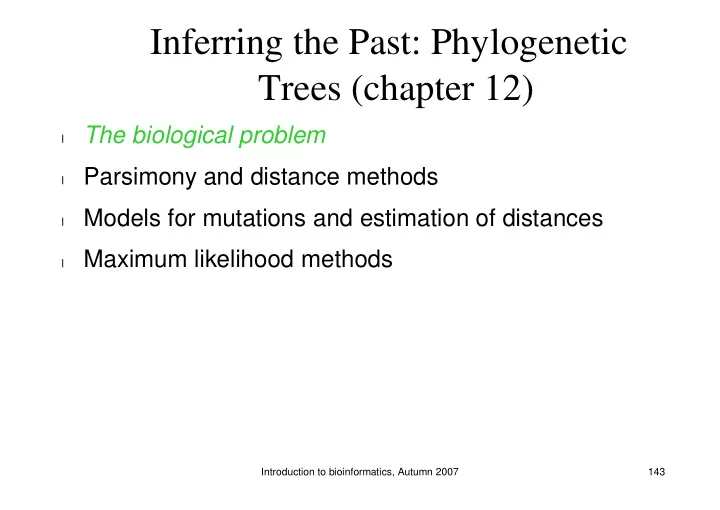

Inferring the Past: Phylogenetic Trees (chapter 12) The biological problem l Parsimony and distance methods l Models for mutations and estimation of distances l Maximum likelihood methods l Introduction to bioinformatics, Autumn 2007 143
Phylogeny • We want to study ancestor- descendant relationships, or phylogeny , among groups of organisms • Groups are called taxa (singular: taxon ) • Organisms are usually called operational taxonomic units or OTUs in the context of phylogeny Introduction to bioinformatics, Autumn 2007 144
Phylogenetic trees • Leaves (external nodes) ~ species, observed (OTUs) 3 • Internal nodes ~ ancestral 2 species/divergence events, 4 7 not observed 8 6 • Unrooted tree does not 1 5 specify ancestor- descendant relationships Unrooted tree with 5 leaves beyond the observation and 3 internal nodes. ”leaves are not ancestors” Is node 7 ancestor of node 6? Introduction to bioinformatics, Autumn 2007 145
Phylogenetic trees 3 R 1 R 2 • Rooting a tree specifies 2 4 all ancestor-descendant 7 8 relationships in the tree 6 • Root is the ancestor to 1 5 root(R 2 ) ) R 1 the other species ( t o o r R 1 • There are n-1 ways to R 2 root a tree with n nodes 8 7 7 6 8 6 1 2 3 4 1 2 3 4 5 5 Introduction to bioinformatics, Autumn 2007 146
Questions Can we enumerate all possible phylogenetic trees for l n species (or sequences?) How to score a phylogenetic tree with respect to data? l How to find the best phylogenetic tree given data? l Introduction to bioinformatics, Autumn 2007 147
Finding the best phylogenetic tree: naive method How can we find the phylogenetic tree that best l represents the data? Naive method: enumerate all possible trees l How many different trees are there of n species? l Denote this number by b n l Introduction to bioinformatics, Autumn 2007 148
Enumerating unordered trees • Start with the only 1 2 1 2 1 2 unordered tree with 3 leaves ( b 3 = 1) 4 4 4 3 3 3 1 2 • Fourth node can be added to 3 different branches (edges), creating 1 new internal branch 3 • Total number of branches is n external and n – 3 internal branches • Consider all ways to add a leaf node to this tree • Unrooted tree with n leaves has 2n – 3 branches Introduction to bioinformatics, Autumn 2007 149
Enumerating unordered trees • Thus, we get the number of unrooted trees b n = (2(n – 1) – 3)b n-1 = (2n – 5)b n-1 = (2n – 5) * (2n – 7) * …* 3 * 1 = (2n – 5)! / ((n-3)!2 n-3 ), n > 2 • Number of rooted trees b’ n is b’ n = (2n – 3)b n = (2n – 3)! / ((n-2)!2 n-2 ), n > 2 that is, the number of unrooted trees times the number of branches in the trees Introduction to bioinformatics, Autumn 2007 150
Number of possible rooted and unrooted trees n B n b’ n 3 1 3 4 3 15 5 15 105 6 105 945 7 954 10395 8 10395 135135 9 135135 2027025 10 2027025 34459425 20 2.22E+020 8.20E+021 30 8.69E+036 4.95E+038 Introduction to bioinformatics, Autumn 2007 151
Too many trees? We can’t construct and evaluate every phylogenetic l tree even for a smallish number of species Better alternative is to l − Devise a way to evaluate an individual tree against the data − Guide the search using the evaluation criteria to reduce the search space Introduction to bioinformatics, Autumn 2007 152
Inferring the Past: Phylogenetic Trees (chapter 12) The biological problem l Parsimony and distance methods l Models for mutations and estimation of distances l Maximum likelihood methods l Introduction to bioinformatics, Autumn 2007 153
Parsimony method The parsimony method finds the tree that explains the l observed sequences with a minimal number of substitutions Method has two steps l − Compute smallest number of substitutions for a given tree with a parsimony algorithm − Search for the tree with the minimal number of substitutions Introduction to bioinformatics, Autumn 2007 154
Parsimony: an example Consider the following short sequences l 1 ACTTT 2 ACATT 3 AACGT 4 AATGT 5 AATTT There are 105 possible rooted trees for 5 sequences l Example: which of the following trees explains the l sequences with least number of substitutions? Introduction to bioinformatics, Autumn 2007 155
9 A A TTT A-> C 7 AAT T T T-> G 6 AA T GT T-> A 8 AC T TT T-> C 3 4 5 2 1 AA C GT AA T GT AA T TT AC A TT AC T TT This tree explains the sequences with 4 substitutions Introduction to bioinformatics, Autumn 2007 156
First tree is 9 A A TTT 4 substitutions… more A-> C 7 AAT T T parsimonious! T-> G 6 AA T GT T-> A 8 AC T TT T-> C 3 4 5 2 1 AA C GT AA T GT AA T TT AC A TT AC T TT T-> G 9 AAT T T 6 substitutions… 8 AA T GT T-> C A-> C 7 A A C G T G-> T C-> T 6 AC C TT C-> A 1 2 3 4 5 AC T TT AC A TT AA C GT AA T GT AA T TT Introduction to bioinformatics, Autumn 2007 157
Recommend
More recommend